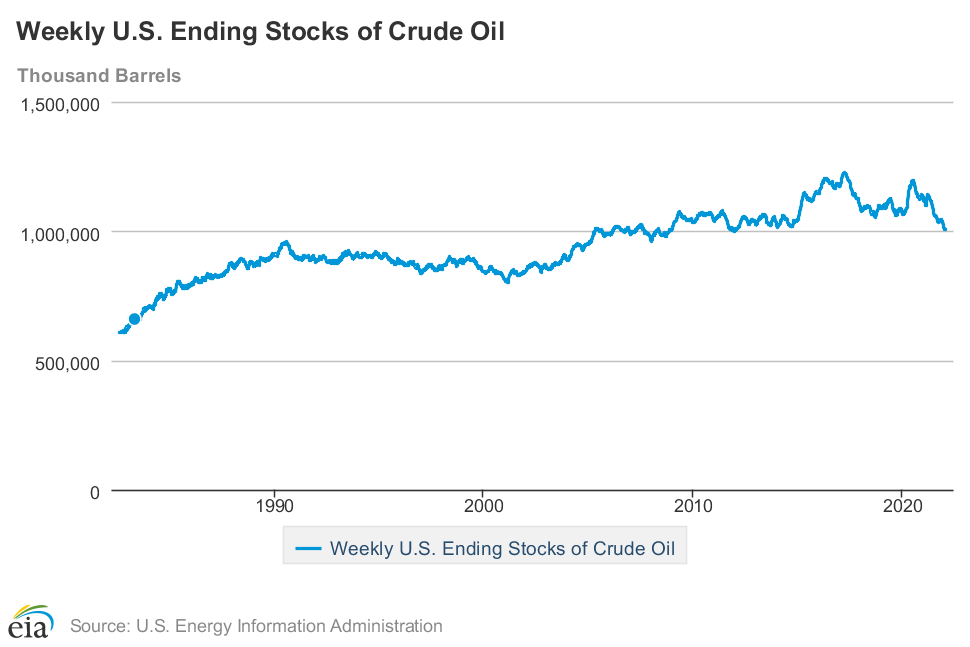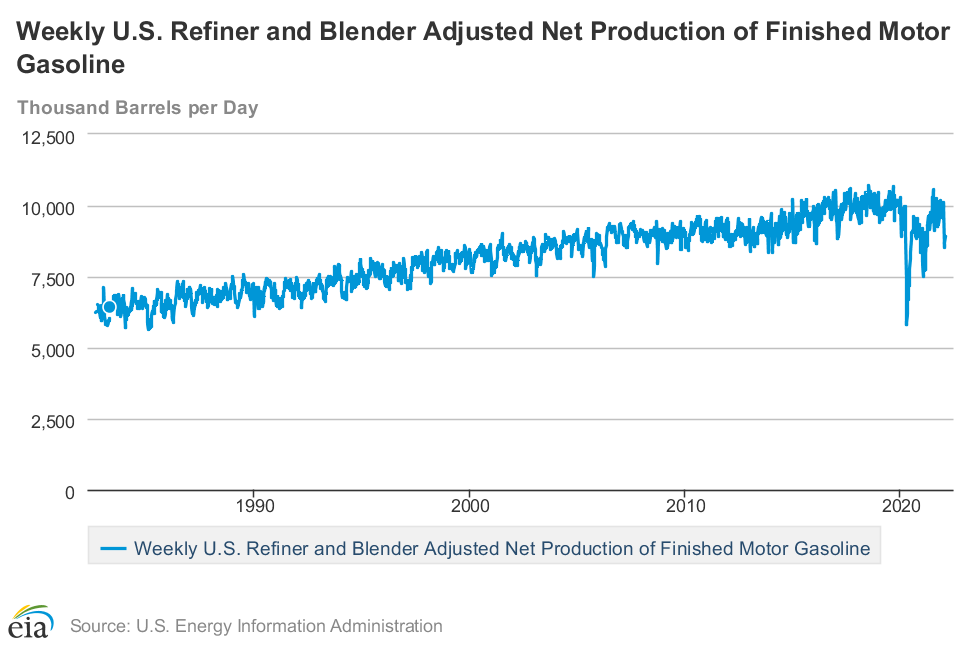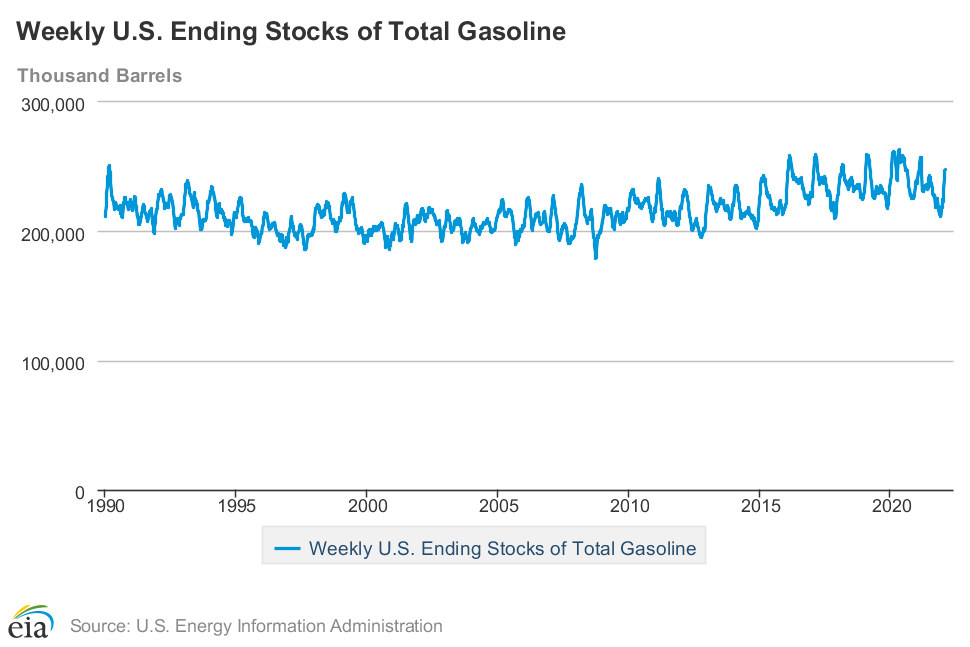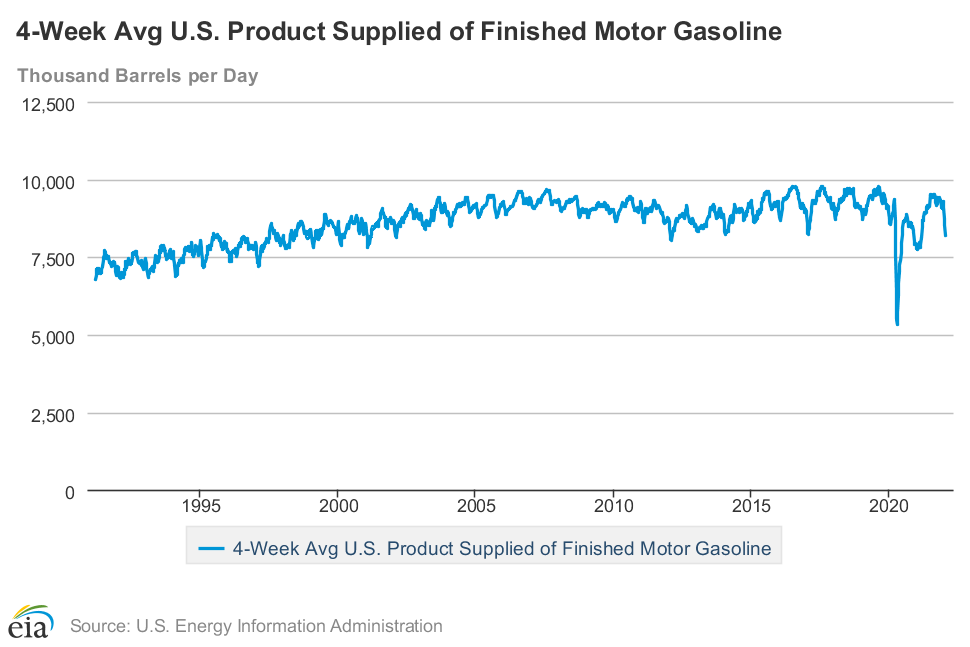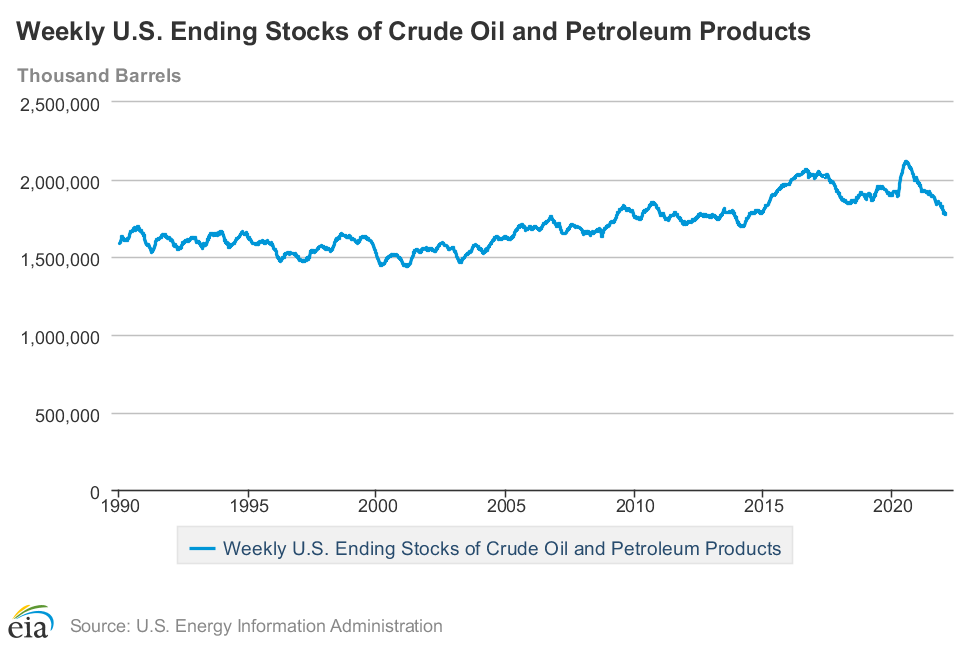Total supplies of oil & products at 7 1/2 year low even after largest 4 week build of gasoline stocks in 32 years SPR inventories are at a new 19 year low; gasoline inventories are up most in any 4 week period since Jan 1990 as gasoline demand, ex worst Covid drops, are at a 10 year low; imports of gasoline are at a 87 week low; total inventories of oil & all products made from it are at 7 1/2 year low The Latest US Oil Supply and Disposition Data from the EIA US oil data from the US Energy Information Administration for the week ending January 21st indicated that despite a drop in our oil imports, a shift in unaccounted for crude from demand to supply and a moderate withdrawal of crude from our Strategic Petroleum Reserve meant we had enough
Topics:
run75441 considers the following as important: Focus on Fracking, Hot Topics, RJS, US/Global Economics
This could be interesting, too:
NewDealdemocrat writes JOLTS revisions from Yesterday’s Report
Joel Eissenberg writes No Invading Allies Act
Joel Eissenberg writes How Tesla makes money
NewDealdemocrat writes January JOLTS report: monthly increases, but significant downward revisions to 2024
Total supplies of oil & products at 7 1/2 year low even after largest 4 week build of gasoline stocks in 32 years
SPR inventories are at a new 19 year low; gasoline inventories are up most in any 4 week period since Jan 1990 as gasoline demand, ex worst Covid drops, are at a 10 year low; imports of gasoline are at a 87 week low; total inventories of oil & all products made from it are at 7 1/2 year low
The Latest US Oil Supply and Disposition Data from the EIA
US oil data from the US Energy Information Administration for the week ending January 21st indicated that despite a drop in our oil imports, a shift in unaccounted for crude from demand to supply and a moderate withdrawal of crude from our Strategic Petroleum Reserve meant we had enough oil left to add to our stored commercial crude supplies for the second time in 9 weeks and for the 12th time in the past thirty-five weeks….our imports of crude oil fell by an average of 509,000 barrels per day to an average of 6,236,000 barrels per day, after rising by an average of 675,000 barrels per day during the prior week, while our exports of crude oil rose by an average of 186,000 barrels per day to an average of 2,796,000 barrels per day during the week, which together meant that our effective trade in oil worked out to a net import average of 3,440,000 barrels of per day during the week ending January 21st, 695,000 fewer barrels per day than the net of our imports minus our exports during the prior week…over the same period, production of crude oil from US wells was reportedly 100,000 barrels per day lower at 11,600,000 barrels per day, and hence our daily supply of oil from the net of our international trade in oil and from domestic well production appears to have totaled an average of 15,040,000 barrels per day during the cited reporting week…
Meanwhile, US oil refineries reported they were processing an average of 15,497,000 barrels of crude per day during the week ending January 21st, an average of 44,000 more barrels per day than the amount of oil that our refineries processed during the prior week, while over the same period the EIA’s surveys indicated that a net of 161,000 barrels of oil per day were being added to the supplies of oil stored in the US…so based on all that reported & estimated data, this week’s crude oil figures from the EIA appear to indicate that our total working supply of oil from net imports and from oilfield production was 617,000 barrels per day less than what our oil refineries reported they used during the week plus what we added to storage during the week…to account for that disparity between the apparent supply of oil and the apparent disposition of it, the EIA just inserted a (+617,000) barrel per day figure onto line 13 of the weekly U.S. Petroleum Balance Sheet to make the reported data for the daily supply of oil and the consumption of it balance out, essentially a balance sheet fudge factor that they label in their footnotes as “unaccounted for crude oil”, thus suggesting there must have been a error or omission of that magnitude in this week’s oil supply & demand figures that we have just transcribed…moreover, since last week’s EIA fudge factor was at (-501,000) barrels per day, that means there was a 1,118,000 barrel per day difference between this week’s balance sheet error and the EIA’s crude oil balance sheet error from a week ago, and hence the week over week supply and demand changes indicated by this week’s report are completely worthless…..however, since most everyone treats these weekly EIA reports as gospel and since these figures often drive oil pricing, and hence decisions to drill or complete oil wells, we’ll continue to report this data just as it’s published, and just as it’s watched & believed to be reasonably accurate by most everyone in the industry…(for more on how this weekly oil data is gathered, and the possible reasons for that “unaccounted for” oil, see this EIA explainer)….
This week’s 161,000 barrel per day increase in our overall crude oil inventories left our total oil supplies at 1,006,972,000 barrels, just 1,845,000 barrel above a 10 year low…this week’s oil inventory increase came as 340,000 barrels per day were being added to our commercially available stocks of crude oil, while 179,000 barrels per day of oil were being pulled out of our Strategic Petroleum Reserve, part of the first installment of Biden’s plan to release 50 million barrels from the SPR, in order to incentive continued use of US gas guzzlers….including the drawdowns from the Strategic Petroleum Reserve under such politically motivated programs, a total of 64,288,000 barrels have been removed from the Strategic Petroleum Reserve over the past 18 months, and as a result the amount of oil left in our Strategic Petroleum Reserve has fallen to the lowest since November 8th, 2002, or to another new 19 year low of 590,782,000 barrels per day, as repeated tapping of our emergency supplies for political expediency or to “pay for” other programs had already drained those supplies considerably over the past dozen years…based on an estimated prepandemic consumption level of around 18 million barrels per day, the US will have roughly 30 1/2 days of oil supply left in the Strategic Petroleum Reserve when the Biden program is complete…
Further details from the weekly Petroleum Status Report (pdf) indicate that the 4 week average of our oil imports fell to an average of 6,233,000 barrels per day last week, which was still 9.8% more than the 5,679,000 barrel per day average that we were importing over the same four-week period last year….this week’s crude oil production was reported to be 100,000 barrels per day lower at 11,600,000 barrels per day even though the EIA’s rounded estimate of the output from wells in the lower 48 states was unchanged at 11,300,000 barrels per day, because Alaska’s oil production was 6,000 barrels per day lower at 449,000 barrels per day and thus subtracted 100,000 barrels per day from rounded national production total (by the EIA’s math)…US crude oil production had reached a pre-pandemic high of 13,100,000 barrels per day during the week ending March 13th 2020, so this week’s reported oil production figure was 11.5% below that of our pre-pandemic production peak, but 37.6% above the interim low of 8,428,000 barrels per day that US oil production had fallen to during the last week of June of 2016…
US oil refineries were operating at 87.7% of their capacity while using those 15,497,000 barrels of crude per day during the week ending January 21st, down from a utilization rate of 88.1% the prior week, and lower than the historical utilization rate for mid-January refinery operations…the 15,497,000 barrels per day of oil that were refined this week were still 5.3% more barrels than the 14,721,000 barrels of crude that were being processed daily during the pandemic impacted week ending January 22nd of 2021, but 2.7% less than the 15,924,000 barrels of crude that were being processed daily during the week ending January 24th, 2020, when US refineries were operating at what was then also a below normal 87.2% of capacity…
With the increase in oil being refined this week, gasoline output from our refineries was again higher, increasing by 229,000 barrels per day to 8,917,000 barrels per day during the week ending January 21st, after our gasoline output had increased by 114,000 barrels per day over the prior week.…hence, this week’s gasoline production was 2.8% more than the 8,885,000 barrels of gasoline that were being produced daily over the same week of last year, but 2.4% less than the gasoline production of 9,158,000 barrels per day during the week ending January 24th, 2020…..at the same time, our refineries’ production of distillate fuels (diesel fuel and heat oil) increased by 28,000 barrels per day to 4,756,000 barrels per day, after our distillates output had decreased by 60,000 barrels per day over the prior week…after that modest increase, our distillates output was 5.2% more than the 4,518,000 barrels of distillates that were being produced daily during the week ending January 22nd of 2021, but 4.5% less than the 4,979,000 barrels of distillates that were being produced daily during the week ending January 24th, 2020…
With the increase in our gasoline production, our supplies of gasoline in storage at the end of the week rose for the seventh time in nine weeks, after falling each week over the preceding six weeks, increasing by 1,297,000 barrels to 247,918,000 barrels during the week ending January 21st,after our gasoline inventories had increased by a record 23,962,000 barrels over the prior three weeks…our gasoline supplies increased by less this week because the amount of gasoline supplied to US users increased by 281,000 barrels per day to 8,505,000 barrels per day, while our imports of gasoline fell by 77,000 barrels per day to a 87 week lowof 314,000 barrels per day and while our exports of gasoline rose by 19,000 barrels per day to 412,000 barrels per day…after four straight big inventory increases, our gasoline supplies are now fractionally higher than last January 22nd’s gasoline inventories of 240,748,000 barrels, but still about 2% below the five year average of our gasoline supplies for this time of the year…
the four week average of our gasoline demand fell by 302,000 barrels to a 44 week low of 8,202,000 barrels per day this week…while that’s 6.1% higher than gasoline demand low of 7,729,000 barrels per day during the Covid surge of last January 22nd, it’s down by 3.9% from the gasoline demand of 8,537,000 barrels per day on Jan 24th 2019, which was the low for that year…except for other pandemic impacted weeks when our demand tanked, our gasoline demand during the last 4 weeks was the lowest in 10 years….meanwhile, the gasoline inventory increase of 25,259,000 barrels over the past 4 weeks was the largest for any four week period on record since 1990, when gasoline inventories jumped by 26,643,000 in the period ending February 9th, handily exceeding the 4 week inventory increase of 23,952,000 barrels that we saw at the outset of the pandemic lockdowns from mid-March to mid April of 2020…
On the other hand, with the recent decreases in our distillates production, our supplies of distillate fuels decreased for the fifteenth time in twenty-two weeks, falling by 2,798,000 barrels to 125,154,000 barrels during the week ending January 21st, after our distillates supplies had decreased by 1,431,000 barrels during the prior week….our distillates supplies fell by more this week because the amount of distillates supplied to US markets, an indicator of our domestic demand, rose by 198,000 barrels per day to 4,754,000 barrels per day, and as our imports of distillates fell by 80,000 barrels per day to 226,000 barrels per day, while our exports of distillatesfell by 56,000 barrels per day to 627,000 barrels per day,….after twenty-eight inventory decreases over the past forty-two weeks, our distillate supplies at the end of the week were 23.1% below the 162,847,000 barrels of distillates that we had in storage on January 22nd of 2021, and about 17% below the five year average of distillates inventories for this time of the year…
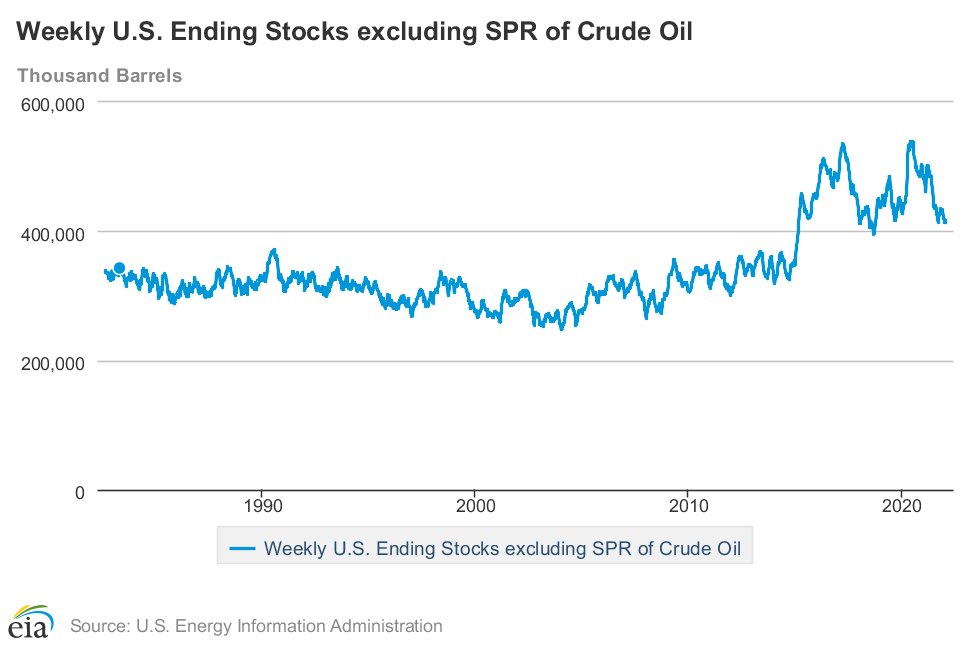
Meanwhile, with the switch in unaccounted for crude from demand to supply and the withdrawal of crude from our Strategic Petroleum Reserve, our commercial supplies of crude oil in storage rose for the 9th time in 25 weeks and for the 18th time in the past year, increasing by 2,377,000 barrels over the week, from 413,813,000 barrels on January 14th to 416,190,000 barrels on January 21st, after our commercial crude supplies had increased by 515,000 barrels over the prior week…after this week’s increase, our commercial crude oil inventories remained about 8% below the most recent five-year average of crude oil supplies for this time of year, but were still about 31% above the average of our crude oil stocks after the third week of January over the 5 years at the beginning of the past decade, with the disparity between those comparisons arising because it wasn’t until early 2015 that our oil inventories first topped 400 million barrels….since our crude oil inventories had jumped to record highs during the Covid lockdowns of spring 2020 and remained elevated for most of the year after that, our commercial crude oil supplies as of this January 21st were 12.7% less than the 476,653,000 barrels of oil we had in commercial storage on January 22nd of 2021, and are now 3.9% less than the 431,654,000 barrels of oil that we had in storage on January 24th of 2020, and also 6.7% less than the 445,944,000 barrels of oil we had in commercial storage on January 25th of 2019…
Finally, with our inventory of crude oil and our supplies of all products made from oil all near multi year lows, we are continuing to track the total of all U.S. Stocks of Crude Oil and Petroleum Products, including those in the SPR….the EIA’s data shows that the total of our oil and oil product inventories, including those in the Strategic Petroleum Reserve and those held by the oil industry, and including everything from gasoline and jet fuel to propane/propylene and residual fuel oil, fell by 5,341,000 barrels this week, from 1,775,470,000 barrels on January 21st to 1,780,811,000 barrels on January 14th…that means our total supplies are now the lowest since June 13th, 2014, or at a seven and a half year low, which is somewhat amazing, in light of the near record increase in gasoline inventories..

